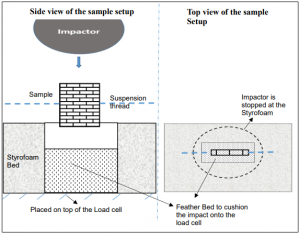
“Bio-inspired damage resistant models have distinct patterns like brick-mortar, Voronoi, helicoidal etc., which show exceptional damage mitigation against high-velocity impacts,” says Akula. “These unique patterns increase damage resistance (in some cases up to 3000 times more than the constituent materials) by effectively dispersing the stress waves produced by the impact. Ability to mimic these structures on a larger scale can be ground-breaking and could be used in numerous applications. Advancements in 3D printing have now made possible fabrication of these patterns with ease and at a low cost. Research on dynamic fracture in bio-inspired structures is very limited but it is crucial for the development of such materials with enhanced impact resistance.”
Akula and colleagues 3D printed a brick-mortar structure made from VeroClear rubber and Tango Black plastic on a Stratasys Objet Connex 3D printer. They investigated damage in the sample through a low-velocity drop test with fixed and free boundary conditions. Under free boundary conditions, no damage was observed, but cracks did form when the sample rested on a fixed metal table.
A 3D peridynamic fracture model was created for the brick-mortar structure, but comparing the computational simulations with the experimental results was unsuccessful because of the computational cost. The fixed boundary conditions required modeling of the steel bed, which was not possible with the lab’s computational abilities, so they used Kalthoff-Winkler experiments instead.
“Kalthoff-Winkler experiment is a benchmark dynamic fracture problem, with the crack angles of 70 degrees reported,” Akula explains. “Our computational results were close with measured angles of 66 degrees for the left and 69 degrees for the right notches. After validating our peridynamic model against Kalthoff-Winkler we did convergence studies to determine the horizon size and m for the peridynamic simulations.”
They then simulated dynamic impact for a single horizontal layer of the soft phase, two horizontal layers, two-tier brick-mortar and three-tier
brick mortar samples. Damage in all cases was limited to the initial brick of impact. A study of soft-phase deformation in the sample showed unrealistic deformation in the three-tier brick and mortal sample.
“It may be because the soft phase was modeled as a linearly elastic material whereas the rubber (soft phase) is a non-linearly elastic sample,” Akula continues. “To resolve this a piecewise continuous non-linear model of the soft phase is modeled. After the non-linear soft phase is modeled it is observed that the deformations in the soft phase are smooth and realistic. Damage in both the linear and non-linear cases appears to be same. This indicates that non-linear model helps in seeing the soft phase more clearly, but the damage is represented accurately even with the linear elastic model.”
Future work includes conducting high velocity impact tests with a gas gun, with computational inputs for the comparison. Additional microstructures will be investigated as well, including inclined platelets, helicoidal and Voronoi patterns.
“The 3D printing parameters effect of the damage must be studied concerning the plane of build for the samples,” Akula concludes. “Computational simulations have to address material penetration and code should be parallelized to accommodate more layers of soft phase and lower volume ratio of soft phase to hard phase in microstructures.”
Discuss this and other 3D printing topics at 3DPrintBoard.com or share your thoughts below.